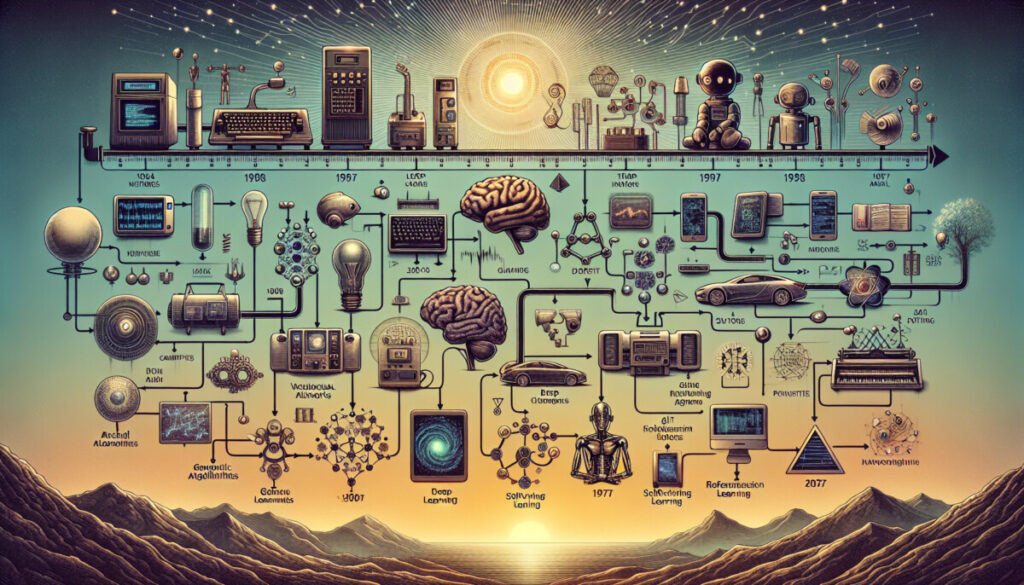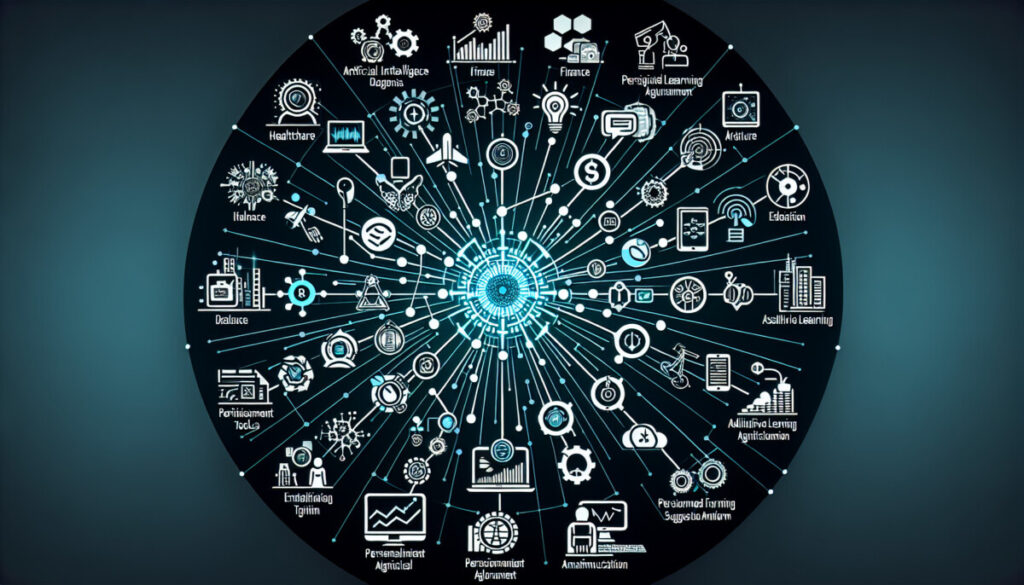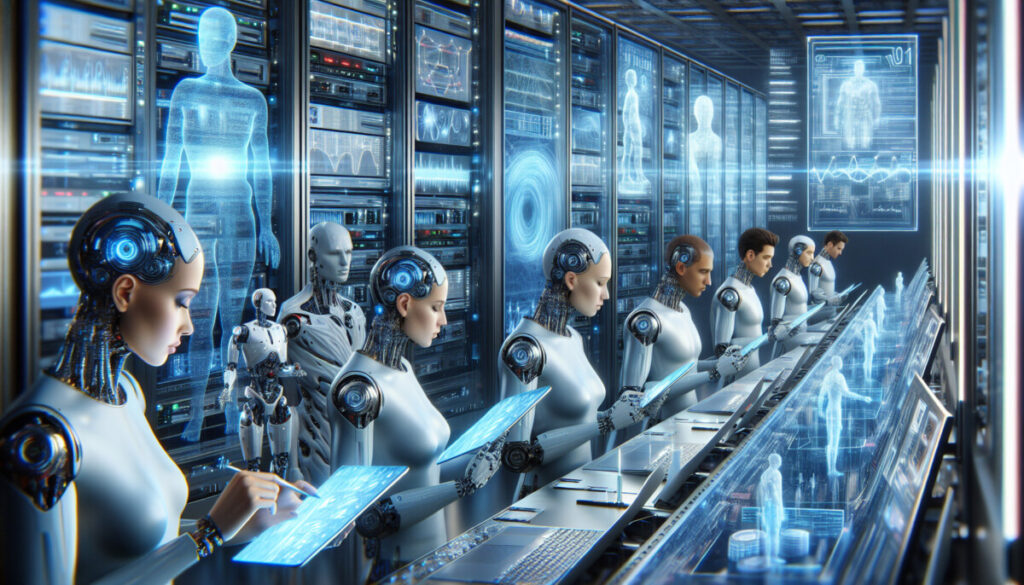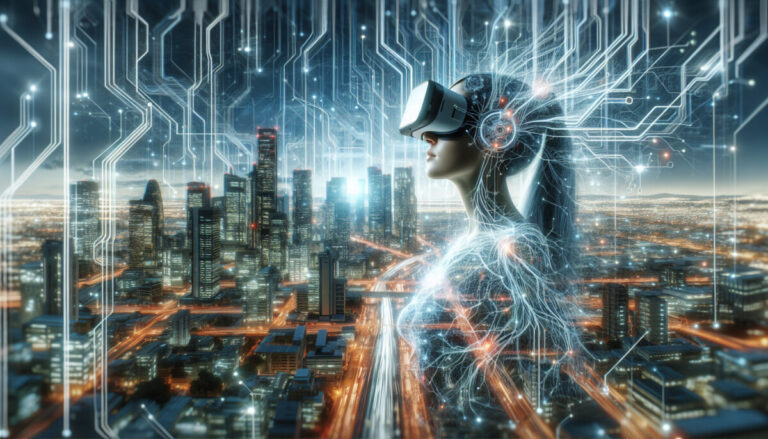The AI and machine learning revolution is transforming various industries and having a significant impact on society. AI and ML technologies are becoming increasingly important, driving innovation and creating new job opportunities. In this comprehensive overview, we will explore the evolution of AI and machine learning, debunk common myths, discuss their applications, navigate the job market, consider ethical considerations, and speculate on the future of these technologies.
Artificial Intelligence: From Concept to Reality
Artificial intelligence has come a long way since its inception. It began as a concept of creating machines that can mimic human intelligence and perform tasks that require human intelligence. Over time, advancements in technology and computing power have enabled the development of AI systems that can learn from data and improve their performance. This evolution has led to the emergence of machine learning, a subset of AI that focuses on algorithms and models that allow computers to learn and make predictions or decisions without being explicitly programmed.
The Rise of Machine Learning
Machine learning has its roots in the 1950s and 1960s, with the development of early AI models and algorithms. However, it wasn’t until the late 1990s and early 2000s that machine learning gained significant traction, thanks to the increase in data availability and computational power. This led to the rise of deep learning, a subset of machine learning that focuses on neural networks and mimicking the structure and function of the human brain.
The Relationship Between AI and Machine Learning
Artificial intelligence and machine learning are closely related. In fact, machine learning is a key component of AI systems. AI systems use machine learning algorithms to analyze large amounts of data and identify patterns and trends that humans may not be able to detect. Deep learning, on the other hand, is a subset of machine learning that focuses on neural networks and processing complex data such as images, videos, and text.
Understanding the Difference
While artificial intelligence and machine learning are related, they are not the same. AI is a broader concept that encompasses various technologies and approaches, including machine learning. Machine learning, on the other hand, is a specific approach within AI that focuses on algorithms and models that allow computers to learn from data.
The Future of AI and Machine Learning
As the AI and machine learning revolution continues to unfold, it is important to understand the evolution of these technologies, their applications, and the ethical considerations associated with their use. By navigating the job market and staying informed about the latest advancements, individuals and organizations can fully leverage the benefits of AI and machine learning while addressing the challenges and ensuring responsible and ethical use.
The Evolution of Artificial Intelligence and Machine Learning
The evolution of artificial intelligence (AI) and machine learning (ML) has been remarkable. It started with theoretical models and basic algorithms and has now evolved into powerful and versatile technologies. AI refers to the development of computer systems that can perform tasks requiring human intelligence, while ML focuses on algorithms that allow computers to learn from data and make predictions or decisions without being explicitly programmed.
Throughout the history of AI and ML, there have been key milestones and breakthroughs that have shaped their development:
- The development of the first neural networks laid the foundation for the era of symbolic AI with rule-based systems.
- The late 1970s to the 1990s saw a period of slowdown and reevaluation known as the AI Winter due to the limitations of existing technologies.
- The late 1990s brought a resurgence of AI with the advent of the internet and the increase in data availability. This led to the rise of ML, as algorithms could now analyze large amounts of data and identify patterns and trends that humans may not be able to detect.
- The increase in computational power and the development of advanced algorithms like deep learning further propelled the evolution of AI and ML.
It’s important to note the relationship between AI, ML, and deep learning. ML is a subset of AI, and deep learning is a subset of ML. Deep learning focuses on neural networks and mimicking the structure and function of the human brain, enabling AI systems to process unstructured data such as images, videos, and text.
While AI and ML are related, they are not the same. AI encompasses a broader range of concepts and technologies, including ML, but also other approaches such as expert systems and natural language processing .

Common Misconceptions About AI and Machine Learning
There are several common misconceptions about AI and machine learning that need to be addressed. Let’s dispel these myths and highlight the positive aspects and potential benefits of AI and machine learning.
Myth 1: Fear of Job Replacement by Machines
One of the biggest myths surrounding AI and machine learning is the fear that they will replace human jobs. While it is true that AI and machine learning can automate certain tasks, they also create new job opportunities and enhance human productivity. For example, in the manufacturing industry, robots and automation have taken over repetitive and dangerous tasks, allowing humans to focus on more complex and creative tasks. This has led to increased efficiency and productivity in many industries.
AI and machine learning also have the potential to create entirely new job roles that didn’t exist before. As AI technology continues to advance, there will be a growing need for AI specialists, data scientists, and machine learning engineers who can develop and implement AI solutions. These roles require a deep understanding of AI and machine learning algorithms, as well as the ability to analyze and interpret large amounts of data.
Myth 2: Superintelligence and World Domination
Another myth is the idea of superintelligence, where machines surpass human intelligence and control the world. While AI and machine learning have made significant advancements, they are still tools that are designed to work alongside humans and augment their capabilities. They are not self-aware beings with their own desires and motivations. AI and machine learning algorithms are programmed to perform specific tasks based on the data they are trained on. They do not possess the ability to think or reason like humans do.
In fact, AI and machine learning are often limited in their capabilities and rely on human input and guidance to function effectively. For example, in self-driving cars, AI algorithms can analyze sensor data and make decisions based on predefined rules, but human drivers are still needed to handle complex situations and make critical judgments. This collaboration between humans and AI systems is essential for successful implementation and adoption.
By dispelling these myths and providing evidence of the positive aspects and potential benefits of AI and machine learning, we can encourage a more informed and realistic understanding of these technologies. AI and machine learning have the potential to revolutionize various industries and sectors, improving efficiency, accuracy, and decision-making. However, it is important to approach their development and implementation with ethical considerations in mind, such as privacy, bias, and accountability.
AI and machine learning are not about replacing human jobs or creating superintelligent machines. They are tools that can enhance human productivity, create new job opportunities, and revolutionize various industries. By understanding the true potential and limitations of AI and machine learning, we can navigate the revolution with confidence and harness the benefits of these technologies.
Applications of AI and Machine Learning in Various Industries
AI and machine learning have revolutionized various industries, offering a diverse range of applications. In this article, we will explore how these technologies are being utilized in the healthcare, finance, and transportation sectors.
Healthcare
- Medical image analysis
- Disease diagnosis
- Personalized treatment plans
By analyzing large volumes of medical data, AI algorithms can identify patterns and make accurate predictions, leading to more efficient and effective healthcare outcomes.
Finance
- Fraud detection
- Accurate predictions
- Optimized investment strategies
AI and machine learning technologies can analyze vast amounts of financial data to detect fraud, make accurate predictions, and optimize investment strategies. They can identify fraudulent activities and potential risks, enabling financial institutions to take necessary actions to protect their customers and assets. AI-powered investment strategies can provide valuable insights and recommendations to help investors make informed decisions and maximize their returns.
Transportation
- Route optimization
- Autonomous vehicles
- Traffic management
AI algorithms can analyze real-time traffic data and optimize routes, reducing congestion and improving overall efficiency. Autonomous vehicles, powered by machine learning, can navigate roads and make decisions based on their surroundings, leading to safer and more reliable transportation systems.
By showcasing real-world examples and success stories, we can illustrate the practical applications and potential future impact of AI and machine learning. These technologies have the power to transform industries and improve efficiency and productivity. As AI and machine learning continue to evolve, we can expect even more innovative applications and advancements in various sectors.
It is crucial for organizations to stay updated with the latest developments and invest in AI talent and infrastructure to fully leverage the benefits of these technologies. Additionally, regulations and policies need to be in place to address ethical and societal implications, ensuring responsible and ethical use of AI and machine learning.

The Demand for AI and Machine Learning Professionals
The demand for AI and machine learning professionals is rapidly growing, making it an exciting field to pursue a career in. However, navigating the job market can be challenging if you’re not familiar with the skills and qualifications needed for these roles.
Key Skills and Qualifications
- Proficiency in programming languages like Python and R
- Solid understanding of statistics and data analysis
- Experience with machine learning frameworks
Proficiency in programming languages like Python and R is crucial for AI and machine learning roles. These languages are widely used in the industry because of their extensive libraries and frameworks specifically designed for data analysis and machine learning tasks. Python, in particular, is highly recommended due to its simplicity, readability, and versatility. It allows data scientists to easily manipulate and analyze large datasets, build machine learning models, and deploy them in production environments.
In addition to programming skills, a solid understanding of statistics and data analysis is essential. AI and machine learning professionals need to be comfortable with concepts such as probability, hypothesis testing, and regression analysis. This knowledge is crucial for interpreting and drawing insights from data, as well as evaluating the performance of machine learning models.
Experience with machine learning frameworks is also highly valued in the job market. Frameworks like TensorFlow, PyTorch, and scikit-learn provide a set of tools and APIs that simplify the process of building and training machine learning models. Familiarity with these frameworks and their associated libraries allows professionals to efficiently develop and deploy sophisticated AI systems.
Job Opportunities
Job opportunities in AI and machine learning span across various industries, including technology, healthcare, finance, and e-commerce.
- Technology: Companies are leveraging AI and machine learning to develop innovative products and services, improve customer experiences, and optimize business operations.
- Healthcare: Organizations are using AI to enhance diagnostic accuracy, predict disease outcomes, and personalize treatment plans.
- Finance: AI is being employed for fraud detection, risk assessment, and algorithmic trading.
- E-commerce: Companies are leveraging AI to provide personalized recommendations, optimize pricing strategies, and improve supply chain management.
Preparing for a Career in AI and Machine Learning
By understanding the skills and qualifications required in the AI and machine learning job market, you can better prepare yourself for a career in this field. Whether you’re a recent graduate or a seasoned professional looking to transition into AI and machine learning, acquiring the necessary skills and gaining practical experience will significantly enhance your job prospects.
Stay updated with the latest advancements in the field, participate in online courses and workshops, and build a strong portfolio of AI and machine learning projects. With the right combination of skills and experience, you’ll be well-equipped to navigate the job market and thrive in the exciting world of AI and machine learning.
The Ethical Considerations of AI and Machine Learning
The rapid advancement of AI and machine learning has brought about numerous benefits and opportunities. However, it also raises ethical challenges and considerations that need to be addressed.
Bias in Algorithms
One of the key concerns is the potential for bias in algorithms. Algorithms are created based on historical data, and if that data contains biases, those biases can be perpetuated in the algorithm. For example, if a recruitment algorithm is trained on historical hiring data that is biased against certain demographics, the algorithm may inadvertently perpetuate that bias by favoring candidates from those demographics. This can result in unfair hiring practices and discrimination.
Data Privacy
Another ethical consideration is data privacy. AI and machine learning systems rely on vast amounts of data to train and improve their performance. However, this data often contains sensitive and personal information. It is important to ensure that this data is protected and used in a responsible and ethical manner. Organizations must take steps to safeguard data privacy and comply with relevant regulations and guidelines.
Misuse of AI and Machine Learning Technologies
Misuse of AI and machine learning technologies is also a significant concern. These technologies have the potential to be used in harmful ways, such as in surveillance systems or autonomous weapons. It is crucial to establish regulations and guidelines to govern the use of AI and machine learning, ensuring that they are used for the benefit of society and adhere to ethical principles.
Responsible AI Development and Deployment
Responsible AI development and deployment are vital to address these ethical considerations. Developers and organizations must prioritize fairness, transparency, and accountability in the design and implementation of AI systems. This includes regularly evaluating algorithms for bias and taking steps to mitigate it, as well as being transparent about the data sources and methods used in developing AI models.
Ethical Guidelines and Regulations
Ethical guidelines and regulations are needed to ensure the responsible use of AI and machine learning technologies. Governments, industry bodies, and organizations must work together to establish frameworks that promote ethical AI practices. These guidelines should address issues such as bias in algorithms, data privacy, and the potential for misuse. By adhering to these guidelines, we can ensure that AI and machine learning technologies are developed and used in a way that benefits society while minimizing potential harm.

The Future of AI and Machine Learning
The future of AI and machine learning holds exciting possibilities. Emerging trends, such as explainable AI and federated learning, are shaping the future of these technologies. AI and machine learning are expected to have a profound impact on society and the economy, revolutionizing industries and transforming the way we live and work. Speculating on future developments, readers can gain insights into the potential of AI and machine learning and the opportunities they may create.
Explainable AI
Explainable AI is a significant trend that is gaining traction in the field of artificial intelligence. As AI systems become more advanced and complex, there is a growing need for transparency and interpretability. Explainable AI focuses on developing algorithms and models that can provide clear explanations for their decisions and actions. This is crucial in domains such as healthcare and finance, where understanding the reasoning behind AI decisions is essential for trust and accountability. By enabling humans to understand and interpret AI outputs, explainable AI is paving the way for more responsible and ethical AI applications.
Federated Learning
Federated learning is another emerging trend that has the potential to shape the future of AI and machine learning. It involves training AI models on decentralized data sources, such as smartphones or edge devices, without the need to transfer the data to a centralized server. This approach addresses privacy concerns by keeping data local while still benefiting from the collective knowledge of a distributed network. Federated learning opens up new possibilities for AI applications in sectors like healthcare, where sensitive patient data can remain secure while contributing to the development of AI models for disease diagnosis or drug discovery.
The Impact on Society and the Economy
The impact of AI and machine learning on society and the economy cannot be underestimated. These technologies have the potential to revolutionize industries across the board, from healthcare and finance to transportation and manufacturing. For example, AI-powered healthcare systems can improve patient diagnosis and treatment by analyzing vast amounts of medical data and identifying patterns and trends that human doctors may miss. In finance, AI algorithms can detect fraudulent transactions and make more accurate predictions in investment analysis. The possibilities are endless.
The Relationship Between AI, Machine Learning, and Deep Learning
Furthermore, AI and machine learning are closely related. Machine learning is a subset of AI that focuses on developing algorithms and models that allow computers to learn and make predictions or decisions without being explicitly programmed. Deep learning, on the other hand, is a subset of machine learning that focuses on neural networks and mimicking the human brain’s structure and function. Deep learning algorithms are particularly effective in processing unstructured data such as images, videos, and text. The relationship between AI, machine learning, and deep learning is a continuum, with each building on the other to advance the field of artificial intelligence.

The Evolution of Artificial Intelligence and Machine Learning
The evolution of artificial intelligence (AI) and machine learning has been a fascinating journey. These technologies have come a long way since their inception, constantly evolving and pushing the boundaries of what is possible.
The roots of AI can be traced back to the 1950s when pioneers like Alan Turing laid the foundation for computer science and the concept of intelligent machines. However, it wasn’t until the late 1990s that AI began to gain mainstream attention and recognition.
Machine Learning: A Subset of AI
Machine learning, a subset of AI, focuses on developing algorithms and models that allow computers to learn and make predictions or decisions without being explicitly programmed. It has its origins in the 1940s and 1950s, with early work on neural networks and pattern recognition.
Over the years, machine learning has undergone significant advancements, fueled by the availability of vast amounts of data and the increase in computational power.
The Relationship Between AI and Machine Learning
The relationship between AI and machine learning is a close one. Machine learning is a key component of AI, providing the algorithms and techniques that enable machines to learn from data and improve their performance over time.
In essence, machine learning is the engine that powers AI, allowing it to analyze large amounts of data and identify patterns and trends that humans may not be able to detect.
Deep Learning: A Subset of Machine Learning
Deep learning, on the other hand, is a subset of machine learning that focuses on neural networks and mimicking the structure and function of the human brain. It has gained significant attention in recent years, thanks to its ability to process unstructured data such as images, videos, and text.
Deep learning has been instrumental in achieving breakthroughs in areas such as computer vision, natural language processing , and speech recognition.
AI and Machine Learning: Similar Yet Different
While AI and machine learning are closely related, they are not the same thing. AI is a broad field that encompasses various technologies and approaches, including machine learning.
Machine learning, on the other hand, is a specific approach within AI that focuses on developing algorithms and models that allow machines to learn from data.




